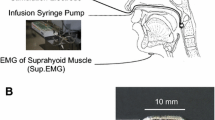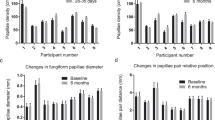Summary
This investigation 1) demonstrates the effect of amiloride on various taste responses in the hamster, and 2) tests the hypothesis that its action on iontophoretic application of taste stimuli parallels its action on bulk flow delivery. Amiloride has not previously been tested in the hamster nor has its effect on iontophoretic stimuli (socalled ‘electric taste’), which is thought to behave similarly to bulk flow stimuli, been examined. Amiloride treatment (4 min of 0.0001M) of the hamster's tongue effectively inhibited chorda tympani responses to NaCl and LiCl solutions. Bulk flow (0.1M) and iontophoretic (+7 μA through 0.001M) presentations of NaCl and LiCl, which had unequal response magnitudes pre-treatment, were inhibited to the same residual response magnitude post-treatment. Recovery then proceeded along two distinct curves asymptotically returning to pre-treatment response levels. These curves could be adequately described by a simple exponential relationship. KCl responses were unaffected when presented via bulk flow techniques but significantly reduced when presented iontophoretically. HCl responses via either method were only slightly diminished. No decrement in response level was observed for the sweet stimuli sucrose (0.5M) or saccharin (−9 μA through 0.001M Na-saccharin) nor for potassium picrate, a bitter stimulus, (0.01M or −10 μA through 0.001M). Amiloride treatment of the hamster tongue was as specific in its action for sodium and lithium as reported in other species, and with the exception of KCl the action of amiloride on iontophoretic stimulation paralleled its action on bulk flow stimulation.
Similar content being viewed by others
References
Beidler LM (1954) A theory of taste stimulation. J Gen Physiol 38:133–139
Beidler LM (1971) Taste receptor stimulation with salts and acids. In: Beidler LM (ed) Chemical senses. (Handbook of sensory physiology, vol IV/2 Taste.). Springer, Berlin Heidelberg New York, pp 200–220
Benos DJ (1982) Amiloride: a molecular probe of sodium transport in tissues and cells. Am J Physiol 242:C131-C145
Bockris J. O'M., Reddy AKN (1970) Modern electrochemistry. Plenum Press, New York, pp 400–402
Brand JG, Teeter JH, Silver WL (1985) Inhibition by amiloride of chorda tympani responses evoked by monovalent salts. Brain Res 334:207–214
DeSimone JA, Ferrell F (1985) Analysis of amiloride inhibition of chorda tympani taste response of rat to NaCl. Am J Physiol 249:R52-R61
DeSimone JA, Heck GL, Mierson S, DeSimone SK (1984) The active ion transport properties of canine lingual epithelia in vitro. Implications for gustatory transduction. J Gen Physiol 83:633–656
Frank ME, Contreras RJ, Hettinger TP (1983) Nerve fibers sensitive to ionic taste stimuli in chorda tympani of the rat. J Neurophysiol 50:941–960
Heck GL, Mierson S, DeSimone JA (1984) Salt taste transduction occurs through an amiloride-sensitive sodium transport pathway. Science 223:403–405
Herness MS (1985 a)Neurophysiological and biophysical evidence on the mechanism of electric taste. J Gen Physiol 86:59–87
Herness MS (1985b) The cathodal OFF response of electric taste in rats. Exp Brain Res 60:318–322
Herness MS, Pfaffmann C (1986) Iontophoretic application of bitter taste stimuli in the hamster. Chem Senses 11:203–211
Hill DL, Bour TC (1985) Addition of functional amiloridesensitive components to the receptor membrane: a possible mechanism for altered taste responses during development. Dev Brain Res 20:310–313
Lamb CF, Dudek J, Thompson H, Caprio J (1984) Amiloride does not suppress taste and olfactory responses to amino acids in the catfish. Abstr 6th Annu Meet Assoc Chemorec Sci, Sarasota FL, April 4–8, p 21
McPheeters M, Roper SD (1985) Amiloride does not block taste transduction in the mudpuppy,Necturus maculosus. Chem Senses 10:341–352
Ninomiya Y, Funakoshi M (1981) Role of ions in generation of taste nerve responses to electrical stimulation in rats. Jpn J Physiol 31:891–902
Ninomiya Y, Mizukoshi T, Higashi T, Funakoshi M (1984) Differential responsiveness of two groups of rat chorda tympani fibers to ionic chemical and electrical tongue stimulations. In: Ueda K (ed) Proc 18th Japanese Symp on Taste and Smell. JASTS, Osaka, Japan, pp 145–148
Olans L, Sariban-Sohraby S, Benos DJ (1984) Saturation behavior of single, amiloride-sensitive Na+ channels in planar lipid bilayers. Biophys J 46:831–835
Pfaffmann C, Pritchard T (1980) Ion specificity of ‘electric taste’. In: van der Starre H (ed) Olfaction and taste, vol 7. IRL Press, London, pp 175–178
Sariban-Sohraby S, Latorre R, Burg M, Olans L, Benos D (1984) Amiloride-sensitive epithelial Na+ channels reconstituted into planar lipid bilayer membranes. Nature 308:80–82
Schiffman SS, Lockhead E, Maes FW (1983) Amiloride reduces the taste intensity of Na+ and Li+ salts and sweetners. Proc Natl Acad Sci USA 80:6136–6140
Smith DV, Bealer SL (1975) Sensitivity of the rat gustatory system to the rate of stimulus onset. Physiol Behav 15:303–314
Teeter JH, Silver WL, Brand JG (1983) Effect of amiloride on chorda tympani responses to salts. Abstr 13th Annu Meet Soc Neurosci Boston MA, Nov 6–11, p 1022
Yamamoto T, Yuyama N, Kawamura Y (1980) Response of cortical taste cells and chorda tympani fibers on anodal D.C. stimulation of the tongue in rats. Exp Brain Res 40:63–70




